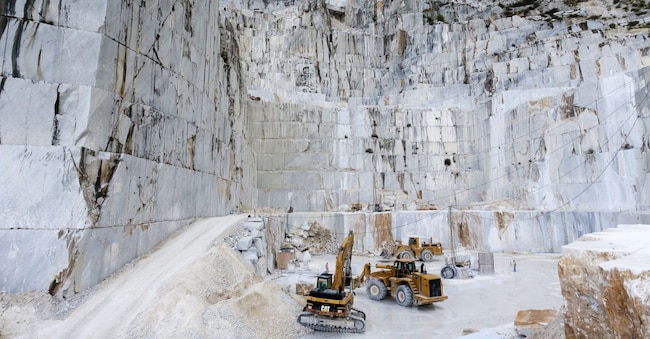Journey into the future of mining after the green light to mining research projects


Before the mines reopen, some time will pass. But the race for critical materials, necessary for the ecological transition, does not stop and, indeed, it is expanding. Because in addition to private initiatives, those that see some companies request exploration permits in various parts of Italy, the 14 projects contained in the national mineral exploration program approved by the Interministerial Committee for the Ecological Transition will be added.
In the North-East, Lombardy and Trentino-Alto Adige will be the focus of research for the presence of fluorite and barite, as well as rare earths located in the Southern Alps. In Piedmont, attention will be focused on the Finero area, where the investigation will concern platinum group metals (PGM). In the same region, an attempt will also be made to evaluate the presence of lithium. Also in Piedmont and Liguria, an attempt will be made to deepen the knowledge of graphite deposits and in Liguria, copper and manganese deposits will also be explored.
In Central Italy, particularly in Tuscany, Lazio, Emilia-Romagna, Marche, the potential of lithium will be analyzed, both in geothermal and sedimentary contexts. In Tuscany, moreover, the well-known deposits of antimony and magnesium of the Colline Metallifere will be studied, while in Lazio the activities will focus on fluorite, also in relation to its concentration in rare earths.
In Southern Italy, Campania will be involved in investigations on lithium, feldspars and other industrial minerals strategic for the national industry, while in Calabria the significant graphite deposits of Sila will be examined. In Sardinia, historically the main Italian mining region, exploration will concern different materials: industrial minerals such as feldspars, zeolites, bentonites and kaolin present in the magmatic areas; fluorite, barite and rare earth mineralizations in the center-south of the island; and the most important metal deposits. In particular, the work will be carried out in the Funtana Raminosa district, where tungsten, rare earths, copper and other sulphides will be investigated, and in the south-western sector of the island, where the interest is focused on copper and molybdenum, associated with tin, bismuth, arsenic and gold.
The starting point is exploration, a necessary process to evaluate the potential of the territories and then proceed with work programs. For the moment it has not yet been defined how we will proceed. That is, whether to proceed with program agreements or with the Regions. Because at the center of the projects are the mining sites with expired concessions and therefore returned to the availability of the State of the Regions. The evaluation "will take place on a case-by-case basis".
In addition to this new program, there are also ongoing private initiatives involving several companies. From Energia Minerals, which operates in Gorno to reactivate the lead and zinc mine, to others that have submitted a request for exploration permits for lithium, cobalt, graphite, and copper.
In Sardinia. In Silius, moreover, work is underway to reactivate the Fluorite mine, a site where there could be a potential for rare earths. Its restart, as Ispra writes, "will represent one of the most important in Europe and will bring a significant contribution to the reduction of Chinese dependence."
In the national panorama, according to the Ispra census that stops at 2023, out of 94 mining concessions still in force, 76 are actually in production especially in Sardinia, Piedmont and Tuscany. The production is linked to the presence of mines of ceramic and industrial minerals (feldspars, kaolin, refractory clays, bentonite, bleaching earths), particularly widespread in the Sardinian granite areas and cement marl, spread along the Apennine ridge and in the Lombard-Venetian Prealps. Rock salt is extracted from the mines of Volterra and Agrigento, while sea salt comes from the salt mines of southern Sardinia.
Metal extraction, however, is still at a standstill. Neither the lead-zinc-silver mine in Gorno in the province of Bergamo nor the magnetite mine in Giacurru in the Nuoro area have been started up yet. "In 20 of the active mines, located in Piedmont, Tuscany, Calabria, Lazio and Sardinia - as stated in the national mining plan prepared by Ispra - feldspar is extracted, an essential mineral for the ceramic industry and in which Italy is a European leader. Its criticality is linked to the strong dependence on Turkey from which the EU imports more than 60% of its needs".
As for the times to start production, they are not exactly short. Fabio Granitzio, a mining geologist with experience at a national and international level, sets them out. Specifically, it goes from the "request and obtaining of the exploration permit", which has a duration that varies from 1 to 3 years. "The exploration permit can be valid for between 3 and 5 years, renewable. From an operational point of view, this phase includes geophysical campaigns, core sampling, surveys and geological studies to estimate resources and feasibility. It requires specific authorizations for field work - argues Granitzio -. Naturally, the types of deposits and the specific geological characteristics and difficulties of the individual prospects also dictate the times and budgets". Then there is the second phase, that is, the one relating to the application for a mining concession. "The duration varies from 2 to 5 years - he adds -. If the resources are economically exploitable, the application for a mining concession is submitted". Then there is the construction and start-up phase which has a duration that varies between 1 and 3 years. Then there are the times for the cultivation (from 10 to more than 30) to the closure and reclamation. «As a consequence of everything, the average time to open a mine in Italy (including authorizations) - Granitzio underlines - can be estimated approximately 8 - 15 years».
News and insights on political, economic and financial events.
Sign upilsole24ore





-U51507044581WFU-1440x752%40IlSole24Ore-Web.jpg%3Fr%3D1170x507&w=3840&q=100)